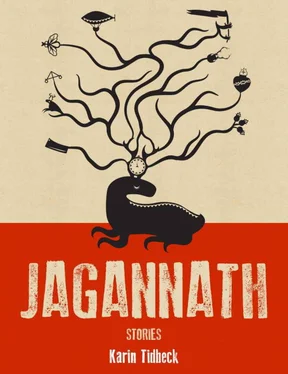A mimic and an infiltrator, Pyret mingles with and assumes the form of pack— or herd animals, changing color and shape to match the others. From a distance it will look like an ordinary animal. It does not grow actual fur, eyes, or other extremities—the features are completely superficial, making it likely that its skin is covered by chromatophores, much like octopi and chameleons.
Although its feeding habits remain unknown, one thing is certain: Pyret does not behave like a predator. There are no records of it causing physical harm, although it insists on physical contact, which has traumatized a number of witnesses. Accounts of Pyret invariably describe a creature that tries to get close, cuddle, and sometimes even mate with the animal or person in question. The adult size of Pyret seems to be anything between a human and a cow. As for lifespan, no Pyre has been observed to die of old age; it has either wandered off or been slain by humans.
Pyret seems to have sought out and coexisted with the farmers of the Nordic countries for centuries. Swedish, Norwegian and Finnish folklore is rife with stories about farmers discovering a fledgling Pyre in a litter of domesticated animals (Tilli, Pia: Nordic Cryptids, Basilisk Förlag, Helsinki 1989, p. 68), indicating that the parent places its spawn with other litters, cuckoo-style. However, Pyret is just as likely to appear in its adult form: there are numerous mentions of strange cows, goats, or sheep appearing in a flock overnight, rubbing up against the other animals. Their presence is often described as having a calming effect. Cows and goats will start producing prodigious amounts of milk, sheep will grow silky soft wool, and pigs fatten up even if food is scarce.
A Gift from the Gods
The earliest mention of Pyret occurs in the Icelandic saga Alfdís saga, in which Alfdís Sigurdardóttir divorces her husband Gunnlaug because he accidentally sets fire to their barn while drunk, “killing six cows and also Freyr’s pyril [2] Old Norse form of the word “pyre,” still in use in Norwegian.
, thereby ruining their family.” (Jónsson, Guðni: Íslendinga sögur, Reykjavík, 1946, book 25, p. 15) Alfdís complains bitterly about the loss of the pyril that she had reared from infancy, and which had kept her cattle happy and fat (Jónsson, p. 16). Because of the death of the pyril, Alfdís is exempt from the normal divorce penalty and retains the family’s remaining possessions, while Gunnlaug is cast out of the community and left destitute (Jónsson, p. 18). Gunnlaug’s punishment and the attribution of the pyril to Freyr, a god of fertility, indicate that it was considered a sacred creature.
This is the first and last mention in Icelandic literature. Afterward and up to modern times, stories and accounts of Pyret are confined to the northern and middle Scandinavian Peninsula, as far south as the pyril of Stavanger(Tilli,p. 69)and as far east as Carelia under the name of pienokainen . [3] Finnish: “tyke”
(Tilli, p. 72) The majority of accounts, however, come from the sparsely populated countryside of northern Sweden.
“The Devil’s Cattle”
The Christianization of Scandinavia dethroned the Norse gods but did little to wipe out belief in supernatural creatures, due in part to all the attention they were given by the Church. The pyril of Norse faith moved into folklore where it becamethe cattle of the vittra, powerful beings that live underground and in hills, similar to the daoine sidhe of Ireland. The Church, seeing it as a very real threat, called Pyret “the Devil’s cattle” and warned the populace not to have dealings with it. Doing so was considered witchcraft. This had the opposite effect, as folklorist Ebbe Schön conjectures: “if the Church made so much noise about them, these creatures must indeed be powerful and therefore worthy of worship.” (Schön, Ebbe: Älvor, vättar och andra väsen, Rabén Prisma, Stockholm, 1996, p.16)
Between the fifteenth and seventeenth centuries, roughly four hundred people were tried and executed for witchcraft and witchcraft-related crimes. [4] The most common witchcraft-related crime was “illegal mingling”: young men consorting with female trolls and vittra.
Twelve instances mention involvement with Pyret. (Leijd, Carl: Rättsprocessens avarter, Meli Förlag, Göteborg 1964, p. 223) Extensive notes from a court case in 1702 concern one Anders of Kräkånger, who was sentenced to death for harboring Pyret. To my knowledge it is also the only trial where Pyret was present. Usually, Pyret would be killed on sight, but Anders of Kräkånger had reared his to such a monstrous size that no one dared touch it. Shaped like a bull, it strode into the courtroom together with Anders and refused to leave his side. The trial was very short, as during the proceedings, “the unholy creature constantly rubbed up against its owner, emitting warbling noises and upsetting those attending, causing many to weep with fear.” (Leijd, p. 257) The court decreed that Anders’s death sentence be carried out immediately but was not quite sure how to deal with Pyret. Anders himself solved this conundrum, offering to go willingly if the court in turn promised to set Pyret free after his death. Considering what he might otherwise command his beast to do, the court accepted this. Whether it intended to keep this promise, we will never know.
Anders of Kräkånger was taken to the block; his beast followed him like a dog and we dared not touch it, not even the priest. The moment the prisoner’s head was severed from his neck, the creature let out a terrible howl, and all who heard it cowered in horror. The creature then fell over and did not move again. When evening fell, it had started to shrink, as when one pours salt on a snail. The remains were shoveled into a trough and burned along with the prisoner’s body. (Leijd, p. 258)
As Pyret constantly seeks out the company of other mammals, I suspect that sometimes it forms an attachment so strong that, like Anders of Kräkånger’s bull, it cannot survive separation. Companionship—belonging to or with someone—seems an intrinsic part of its being.
The case of Anders of Kräkånger was to be the last in the history of Pyret-related trials. The arrival of rationalism changed the face of Scandinavian faith and superstition in a way Christianity had not. Scientist Carl Linnaeus held a lecture in 1762 during which he reached the conclusion that belief in “Pyret, nixies, vittra and their ilk” is a warning sign of what happens to a people that do not concern themselves with science:
These creatures would lurk among cows and goats, haunt every nook, live with us like house cats; and superstition, witchcraft, and warding swarm around us like gnats. (Levertin, Oscar: Carl von Linné. Lectures, Albert Bonniers Boktryckeri, Stockholm, 1910, p. 50)
Pyret was officially wiped out of existence. This did not stop it from appearing.
Sjungpastorn: the Singing Pastor of Hålträsket
Accounts of Pyret assuming human shape are nearly nonexistent. There are three possible reasons:
a) It is non-sentient. Observations of dead specimens may support this, as they universally mention gelatinous bodies with nothing resembling a brain, nervous system, or inner organs (see, for example, Widerberg, Emilia: Folk Tales of the Macabre, Bragi Press, Oxford 1954);
b) It prefers non-sentient mammals (see all the above cases);
c) It is sentient and does frequently take human shape, but witnesses identify it as something else entirely, for example, a vittra, changeling or troll.
Читать дальше












![Карин Тидбек - Аматка [ЛП]](/books/438406/karin-tidbek-amatka-lp-thumb.webp)